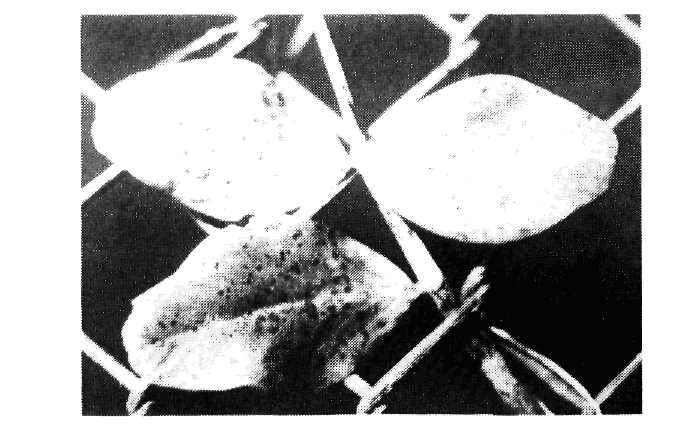
|
Pisum Genetics |
Volume 23 |
1991 |
Research Reports |
pages 38-39 |
Brown leaf spots (bls): a new gene on chromosome 6
|
Swiecicki, W.K. |
Plant Experiment Station, Wiatrowo, 62100 Wagrowiec, Poland |
A mutant characterised by brown, necrotic spots on the leaf surface was selected in 1980 from an M2 population derived from cv Paloma (seed treated with 0.014% NEU). Segregation in this M2 population suggested monogenic inheritance of the trait. After multiplication, the mutant line was incorporated into the Wiatrowo pea collection under catalogue number Wt16120 and the mutation type (brown leaf spots) was described in 1983 (3). For genetic analysis of the inheritance and linkage of the mutant, line Wt16120 was crossed in 1988 with tester lines Wt10345, Wt11143, Wt11238, Wt11288, Wt11745 and Wt15860. F2 populations of 150-200 plants for each cross were grown in the field in 1990. The new trait showed undisturbed, monohybrid segregation in each cross (e.gs Table 1 or cross Wt16120 x Wt15860 with 127 normal and 41 mutant plants; c2 = 0.03) and the symbol bls (brown leaf spots) is assigned here for the recessive allele responsible for the trait. The phenotype is shown in Fig. 1.
The above six crosses enabled dihybrid segregation to be examined for bls and the following markers: A, d, i (chr. 1), k, wb ,s (chr. 2), b, st, M (chr.3), n (chr. 4), Fs, creep, ce, te, gp, cp (chr. 5), wlo, Pl (chr 6) and coch, tl, r, wsp (chr. 7). No significant deviations from normal dihybrid segregation were observed for bls and most markers. However, the data from cross Wt16120 (bls Wlo pl) x Wt10345 (Bls wlo Pl) showed clear evidence of linkage between bls and group 6 markers wlo and Pl (Table 1) and the following gene order is indicated based on the Blixt (1) version of the pea map.

On Blixt's chromosome map there are no more genes above wlo. The version of Weeden and Wolko (4) considers in this segment two additional morphological markers and three biochemical loci (art-1 na rp122 wlo Gpi-c Acp-4 Pl ). Folkeson (2) suggests some changes in the order of the main markers of this chromosome (art-1 lt p na wlo Pl). Therefore bls could be useful in further mapping chromosome 6, especially the segment wlo-na.
Blixt, S. 1977. PNL 9 Suppl.
Folkeson, D. 1990. Doc. dissert., Univ. of Lund, Sweden.
Swiecicki, W.K. 1983. Hod. Rosl. Akl. Nas. 27(4):221-276.
Weeden, N.F. and
Wolko, B. 1990. In Genetic Maps, Ed S. O'Brien, Cold
Spring Harbor
Press, pp. 6106-6112.
Table 1. Phenotypic distribution in an F2 population from cross Wt16120 (brown leaf spots) x Wt10345 (tester line)
|
Monohybrid segregation |
||||||||||
|
Phenotype (number) |
Total |
Chi-square (3:1) |
||||||||
|
Bls (145) bls (56) |
201 |
0.88 |
||||||||
|
Wlo (160) wlo (43) |
203 |
1.58 |
||||||||
|
Pl (142) pl (60) |
202 |
2.38 |
||||||||
|
Joint segregation of Bls with wlo and Pl |
||||||||||
|
Phenotype |
Total |
Joint chi-sq. |
Recomb. fract. |
S.E. |
Phase |
|||||
|
Bls Wlo |
Bls wlo |
bls Wlo |
bls wlo |
|
|
|
|
|
||
|
102 |
43 |
56 |
1 |
201 |
18.69 |
14.2 |
6.9 |
R |
||
|
Bls Pl |
Bls pl |
bls Pl |
bls pl |
|
|
|
|
|
||
|
116 |
29 |
24 |
31 |
200 |
25.11 |
28.9 |
3.9 |
C |
||
|
Wlo Pl |
Wlo pl |
wlo Pl |
wlo pl |
|
|
|
|
|
||
|
101 |
58 |
41 |
2 |
202 |
16.42 |
19.6 |
6.7 |
R |
||

Fig. 1. Leaflets showing the bls (brown leaf spots) phenotype.